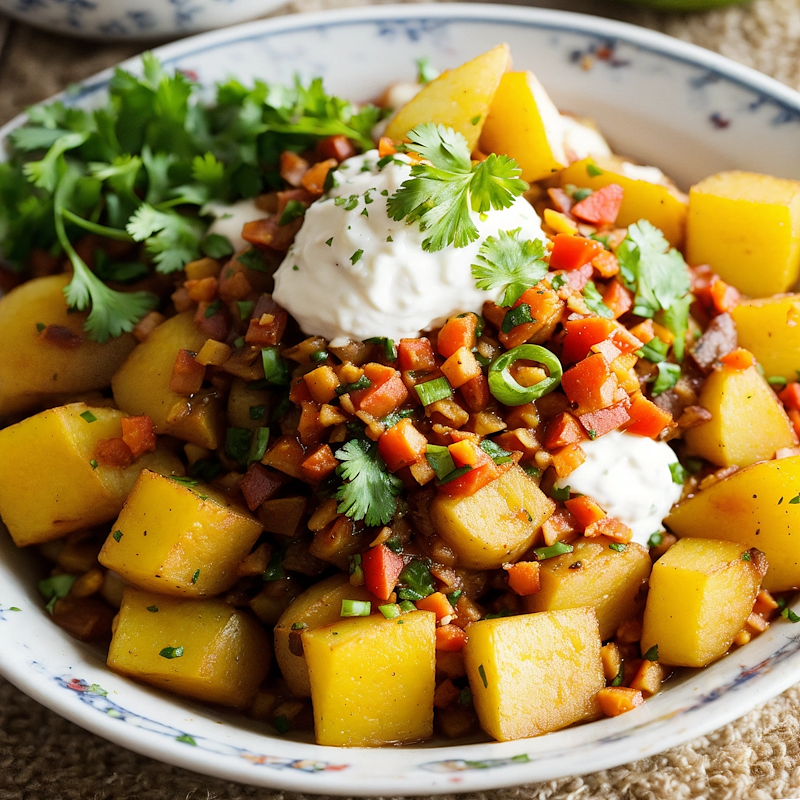Solterito salad with potatoes Peru
 Garanties sécurité
Garanties sécurité
(à modifier dans le module "Réassurance")
 Politique de livraison
Politique de livraison
(à modifier dans le module "Réassurance")
 Politique retours
Politique retours
(à modifier dans le module "Réassurance")
Solterito Salad with Potatoes (Peru)
Solterito Salad is a typical dish from Peru, especially consumed in the Andean region. This fresh and colorful dish combines potatoes, Lima beans, fresh vegetables, herbs, and sometimes cheese, all seasoned with olive oil and vinegar. It’s a refreshing salad rich in flavor, ideal as a side dish or served as a light meal.
Origin and History of Solterito Salad
Solterito Salad gets its name from "soltero," a Spanish word meaning "single." This name has cultural significance, as the dish was traditionally prepared for single men in rural Andean regions, serving as a simple yet nutritious meal that was easy to make for young men or those living alone. The key ingredient, the potato, is inseparable from Peruvian cuisine, as Peru is the birthplace of the potato, with more than 3,000 varieties grown in the mountains.
The history of this salad dates back to past centuries when Andean residents prepared meals with local products like potatoes, Lima beans, and corn, all of which are featured in this recipe. These ingredients are considered treasures of Andean culture and are used in many traditional dishes, including Solterito Salad.
Ingredients for Solterito Salad
- Potatoes (Papa): Potatoes are the base of many Peruvian recipes. The variety used in Solterito should be firm enough not to fall apart during cooking. In Peru, the Andean potato is often preferred for its unique texture and flavor.
- Lima Beans (Tarwi or Frejol de Lima): These beans are rich in protein and a staple in Andean cuisine. They add a pleasant texture and a mild flavor.
- Corn (Mote): Corn is an emblematic ingredient of Peruvian cuisine. In this salad, it adds crunch and sweetness. The corn can be fresh, canned, or frozen, depending on availability.
- Rocoto Pepper (Rocoto or Ají): This pepper is characteristic of the Peruvian Andes. It’s used in many recipes for its powerful taste and heat, typical of regional chilies. It’s often compared to bell peppers, but its heat is much stronger.
- Quesillo Cheese: A fresh cheese commonly used in Peruvian recipes to add a creamy, salty touch.
- Fresh Herbs: Especially cilantro (culantro), which is highly valued in Andean cooking for its fresh, herbaceous flavor.
Preparation of Solterito Salad
- Cooking the Potatoes: Boil the potatoes in salted water until tender but firm. Let them cool.
- Preparing the Other Ingredients: While the potatoes cool, prepare the other ingredients: wash, peel, and chop the tomatoes, onions, rocoto pepper, cilantro, and olives. Cook the Lima beans if they are not already prepared.
- Assembling the Salad: In a large bowl, combine the cooled potatoes, Lima beans, corn, tomatoes, red onions, rocoto pepper, olives, and diced quesillo cheese. You can also add roasted potatoes for a different texture.
- Seasoning: Drizzle olive oil and white vinegar over the salad. Season with salt and pepper to taste. Add finely chopped cilantro and mix gently.
- Refrigeration: Let the salad rest in the refrigerator for about 30 minutes to allow the flavors to meld.
- Serving: Serve the salad chilled, accompanied by grilled meat or with bread for a light meal.
Quechua and Aymara Words Related to This Recipe
The Andean people of Peru, where this dish is popular, often speak indigenous languages like Quechua and Aymara. Here are a few words related to Andean cuisine:
- "Papa" (Quechua): Means "potato." This term is used throughout the Andean region to refer to the essential tuber in Peruvian cuisine.
- "Ñuñu" (Quechua): Means "milk," often used in sauces or to accompany dishes like Solterito.
- "Ch'arki" (Quechua): Dried meat, often consumed with potatoes or corn in Andean cuisine.
- "Kallpa" (Quechua): Strength or energy, which the people of the Andes find in their nourishing dishes based on corn and potatoes.
- "Waña" (Aymara): Means "corn," an essential ingredient in this salad.
Tips and Variations
- For More Spice: You can adjust the amount of rocoto pepper according to your personal preference. If you want a milder flavor, you can substitute rocoto with a less hot type of pepper.
- Cheese Alternative: If you can’t find quesillo cheese, you can use a fresh cheese like ricotta or light goat cheese.
- Add Tuna or Avocado: For a complete meal, you can add chunks of tuna or avocado for more creaminess and protein.
Cultural Significance of Solterito Salad
Solterito Salad reflects the harmony of traditional Andean ingredients. It embodies the simplicity and richness of the Quechua and Aymara cultures, who use local products to create nourishing and flavorful dishes. This dish is often prepared during family gatherings, local festivities, and celebrations in the mountain regions of Peru. The solterito, with its freshness and simplicity, reflects rural traditions that emphasize the use of natural, local, and seasonal products.
Conclusion
Solterito Salad is more than just a dish: it is a Peruvian culinary tradition that has been passed down through the centuries. It blends the flavors of the Andes and reminds us of the importance of preserving local products and ancestral recipes. By using Quechua and Aymara words, we gain a deeper understanding of the rich and diverse heritage of Peru, where each ingredient tells a story of culture, terroir, and ancestral know-how.


